Paul Needham’s masterclass at Cambridge University Library – A post by Satoko Tokunaga (Keio University)
On the afternoon of June 7, a workshop entitled “Collation and Composition in the Fifteenth Century” was conducted by Dr Paul Needham in the Sir Geoffrey Keynes Room, a perfect place for this special occasion. The main topic of this workshop was, as the title reveals, the collation and composition of incunabula. Borrowing Dr Needham’s words, it was a most timely topic for this workshop, for 2011 marks the 150th anniversary of the “invention” of the collational formula by Henry Bradshaw (1831-86), an eminent bibliographer and librarian with a deep connection with Cambridge.
The collation is essential for us to learn, and most of us probably learned about it in foundational texts such as W. W. Greg’s “Formulary of Collation” (The Library (1934), 4th ser. XIV. no. 4), Fredson Bowers’ Principles of Bibliographical Description (1949; repr. 1994, etc.) and Philip Gaskell’s New Introduction to Bibliography (1972; corrected ed. 1974; paperback ed. 1995, etc.). Needless to say, bibliographers are trained to describe a book using the collational formula. It is an essential but not an easy task. I cannot help asking myself how much of my life I have spent counting the number of leaves in books. Of course, counting matters in the book world, but Dr Needham raised a further essential question: What, then, is collation? Why does it matter? In this workshop, we were awakened by this fundamental question, and through his wonderfully clear talk, together with stunningly beautiful books, we were able to see how much collation can reveal about the composition of a book, which provides new insights into the actual process of early printing.
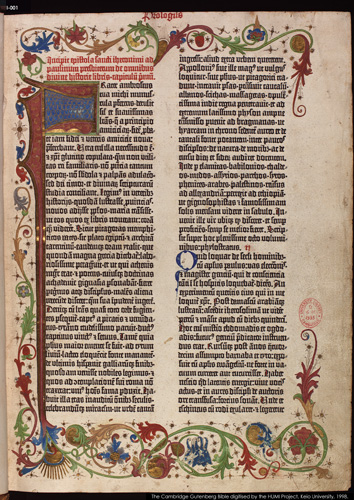 First, Dr Needham pointed out that few people described the concept of collation and also that little acknowledgement was made of Bradshaw’s invention. Using Bradshaw’s handwritten memo on the collation of a mid-15th century manuscript in the Scheide Library, Dr Needham emphasized that Bradshaw’s method could reveal the physical composition or structure of a book in a simpler but clearer way than those proposed by scholars after him, such as Greg and Bowers. Then, he showed an example of the collational formula, using the CUL copy of the Gutenberg Bible (B42) [ISTC ib00526000], i.e. Inc.1.A.1.1[3761]. Of course, it does not mean that Bradshaw’s method can solve anything; there may be some limitations (and in the midst of the workshop, it was hotly argued whether there was any perfect method that could both describe the collation of an ideal copy and record the physical condition of a copy at hand, such as a lack of leaves, in a single and clear form). However, it has certain merits, for example, making a singleton leaf in a quire explicit. In a bibliographical study, such an anomaly may reveal something about book production, and Dr Needham presented the case that the blank page of the singleton in quire 25 of the B42 might explain something about the editorial decision (or hesitation?) to include the apocryphal chapter 4 of Ezra, using a handout of the collation formula handwritten by himself.
First, Dr Needham pointed out that few people described the concept of collation and also that little acknowledgement was made of Bradshaw’s invention. Using Bradshaw’s handwritten memo on the collation of a mid-15th century manuscript in the Scheide Library, Dr Needham emphasized that Bradshaw’s method could reveal the physical composition or structure of a book in a simpler but clearer way than those proposed by scholars after him, such as Greg and Bowers. Then, he showed an example of the collational formula, using the CUL copy of the Gutenberg Bible (B42) [ISTC ib00526000], i.e. Inc.1.A.1.1[3761]. Of course, it does not mean that Bradshaw’s method can solve anything; there may be some limitations (and in the midst of the workshop, it was hotly argued whether there was any perfect method that could both describe the collation of an ideal copy and record the physical condition of a copy at hand, such as a lack of leaves, in a single and clear form). However, it has certain merits, for example, making a singleton leaf in a quire explicit. In a bibliographical study, such an anomaly may reveal something about book production, and Dr Needham presented the case that the blank page of the singleton in quire 25 of the B42 might explain something about the editorial decision (or hesitation?) to include the apocryphal chapter 4 of Ezra, using a handout of the collation formula handwritten by himself.
Indeed, to collate a book, we need not only to count the number of leaves, but also to scrutinize the book itself. Then, we might get a chance to find what has not been unearthed over hundreds of years, as Dr Needham did. In the last part of the workshop, he told of a wonderful episode concerning his discovery of an exemplar, as if restaging it, using the actual books he had examined. More than two decades ago, he found that “#” marks appeared regularly in the CUL copy of the B42 and further identified that they matched the page breaks of the third of the Vulgate editions printed in Strassburg by Heinrich Eggestein, c. 1469 [ISTC ib00533000], a copy of which is Inc.1.A.2.3[84] in CUL .
[The images reproduce the beginning of the Gospel of Luke in the Gutenberg Bible, vol. 2, leaves [217] verso – [218] recto in vol. 2, and the Eggestein Bible, vol. 2, leaf [215] verso]
**********************************************************
[The marginal marks on the leaves of the CUL copy of the Gutenberg Bible match the beginning and the end of the text on leaf [215] verso of the Eggestein Bible]
***********************************************************
This means that the “#” marks were addedby compositor(s) in Eggestein’s printing shop in Strassburg and the CUL copy of the B42 served as the copy-text for Eggestein’s edition. In fact, 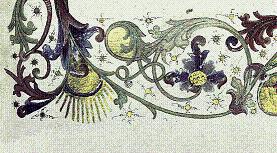 this observation matched a study on illumination by Prof. Eberhard König, who proposed that the CUL copy of the B42 had been illuminated in either Basel or Strassburg. In early printing, there survive only a few books whose copy-texts have been identified, and it is therefore amazing to find such an example among monumental books like the B42.
this observation matched a study on illumination by Prof. Eberhard König, who proposed that the CUL copy of the B42 had been illuminated in either Basel or Strassburg. In early printing, there survive only a few books whose copy-texts have been identified, and it is therefore amazing to find such an example among monumental books like the B42.
What I have summed up here is only part of the talk. For example, details about Dr Needham’s discovery of the CUL copy of the B42 being used as a copy-text can be found in his article “A Gutenberg Bible Used as Printer’s Copy by Heinrich Eggestein in Strassburg, ca. 1469”, Transactions of the Cambridge Bibliographical Society, 9 (1986). On Henry Bradshaw, see his The Bradshaw Method: Henry Bradshaw’s Contribution to Bibliography (1988). After listening to his talk, I can vividly envisage what he explains in his articles, and above all, I find more joy in collation than ever before. It is all thanks to his well-organized talk and the preparation by the staff of the Rare Books Room. Indeed, it was really wonderful to have the original materials, and it was generous of the organizers to allow attendees to freely examine them during and after the workshop. Moreover, questions from the attendees were fascinating (and the size of the group was perfect for that), though they sometimes interrupted the flow of Dr Needham’s talk. Nevertheless, he gave deliberate thought to answering all of them, always getting his talk back on track beautifully. While writing this, I am still excited that I was able to be there, and I am sincerely grateful to Dr Needham and the staff of the Munby Rare Books Room for organizing the workshop. I am looking forward to future occasions!
Satoko Tokunaga
June 2011

![Inc.1.A.2.3[84], f. [215]v - reduced](https://inc-blog.lib.cam.ac.uk/wp-content/uploads/2011/07/Inc.1.A.2.384-f.-215v-reduced3.jpg)
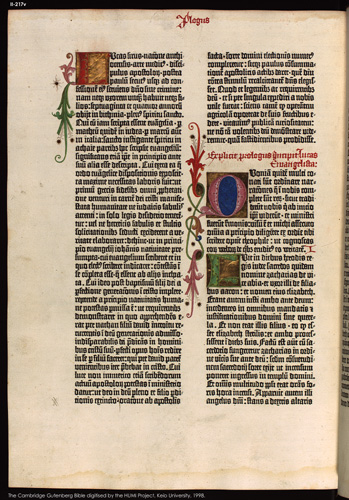
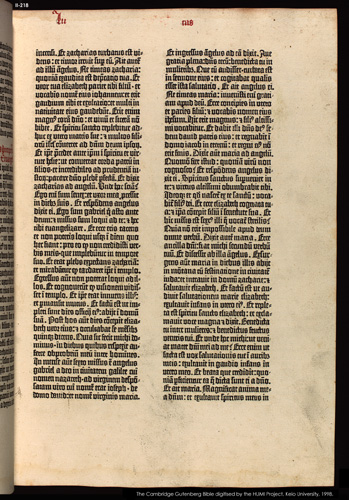
![Inc.1.A.1.1[3761], 2, [y6]v - first mark](https://inc-blog.lib.cam.ac.uk/wp-content/uploads/2011/07/Inc.1.A.1.13761-2-y6v-first-mark3.jpg)
![Inc.1.A.2.3[84], f. [215]v - first line](https://inc-blog.lib.cam.ac.uk/wp-content/uploads/2011/07/Inc.1.A.2.384-f.-215v-first-line3.jpg)
![Inc.1.A.1.1[3761], 2, [y7]r - second mark](https://inc-blog.lib.cam.ac.uk/wp-content/uploads/2011/07/Inc.1.A.1.13761-2-y7r-second-mark3.jpg)
![Inc.1.A.2.3[84], f. [215]v - last line](https://inc-blog.lib.cam.ac.uk/wp-content/uploads/2011/07/Inc.1.A.2.384-f.-215v-last-line1.jpg)
![Inc.3.J.1.3[3576], a1, Sarum Missal - reduced](https://inc-blog.lib.cam.ac.uk/wp-content/uploads/2011/04/Inc.3.J.1.33576-a1-Sarum-Missal-reduced.jpg)
![Inc.3.J.1.3[3576], Sarum Missal, calendar - reduced](https://inc-blog.lib.cam.ac.uk/wp-content/uploads/2011/04/Inc.3.J.1.33576-Sarum-Missal-calendar-reduced.jpg)
![Inc.3.J.1.3[3576], Sarum Missal, explicit - reduced](https://inc-blog.lib.cam.ac.uk/wp-content/uploads/2011/04/Inc.3.J.1.33576-Sarum-Missal-explicit-reduced.png) The book’s history during the later sixteenth and seventeenth centuries is unrecorded. In 1693 it was given by one “Arnold de Wycomb” to George Whitton. Whitton was a graduate of King’s College and native of Wycombe in Buckinghamshire who incorporated at Oxford in the same year he received the book; the unidentified Arnold is presumably a relative or family friend from the same place. The Missal must have passed into the collection of Bishop John Moore shortly after that date and would have reached the library with the remainder of the Bishop’s collection in 1715. It was probably given its rather workaday half-leather binding shortly afterwards.
The book’s history during the later sixteenth and seventeenth centuries is unrecorded. In 1693 it was given by one “Arnold de Wycomb” to George Whitton. Whitton was a graduate of King’s College and native of Wycombe in Buckinghamshire who incorporated at Oxford in the same year he received the book; the unidentified Arnold is presumably a relative or family friend from the same place. The Missal must have passed into the collection of Bishop John Moore shortly after that date and would have reached the library with the remainder of the Bishop’s collection in 1715. It was probably given its rather workaday half-leather binding shortly afterwards.![Inc.1.A.1.3a[3762], I, [a1]r - reduced](https://inc-blog.lib.cam.ac.uk/wp-content/uploads/2011/04/Inc.1.A.1.3a3762-I-a1r-reduced.jpg)
![SSS.4.14, [r10]r - reduced - blog](https://inc-blog.lib.cam.ac.uk/wp-content/uploads/2010/09/SSS.4.14-r10r-reduced-blog11.jpg)
![SSS.4.14, [r9]v - reduced - blog](https://inc-blog.lib.cam.ac.uk/wp-content/uploads/2010/09/SSS.4.14-r9v-reduced-blog2.jpg)
![SSS.4.14, [r9]v - detail - blog](https://inc-blog.lib.cam.ac.uk/wp-content/uploads/2010/09/SSS.4.14-r9v-detail-blog.jpg)
![SSS.4.14, [r10]r - detail - blog](https://inc-blog.lib.cam.ac.uk/wp-content/uploads/2010/09/SSS.4.14-r10r-detail-blog.jpg)
![SSS.4.14, fol. [a1]r - reduced - blog](https://inc-blog.lib.cam.ac.uk/wp-content/uploads/2010/09/SSS.4.14-fol.-a1r-reduced-blog4.jpg)
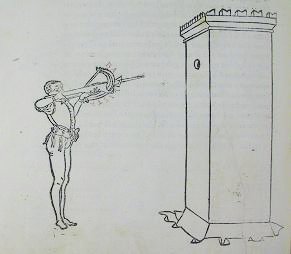


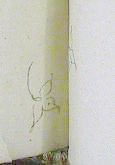
![SSS.4.14, [c5]v - blog](https://inc-blog.lib.cam.ac.uk/wp-content/uploads/2010/09/SSS.4.14-c5v-blog3.jpg)
![Inc.2.B.19.4[2163], c7v - blog](https://inc-blog.lib.cam.ac.uk/wp-content/uploads/2010/09/Inc.2.B.19.42163-c7v-blog11.jpg)
![SSS.4.14, fol. [r8]v - blog detail of caption](https://inc-blog.lib.cam.ac.uk/wp-content/uploads/2010/09/SSS.4.14-fol.-r8v-blog-detail-of-caption.jpg)
![SSS.4.14, fol. [s6]v - blog detail](https://inc-blog.lib.cam.ac.uk/wp-content/uploads/2010/09/SSS.4.14-fol.-s6v-blog-detail1.jpg)